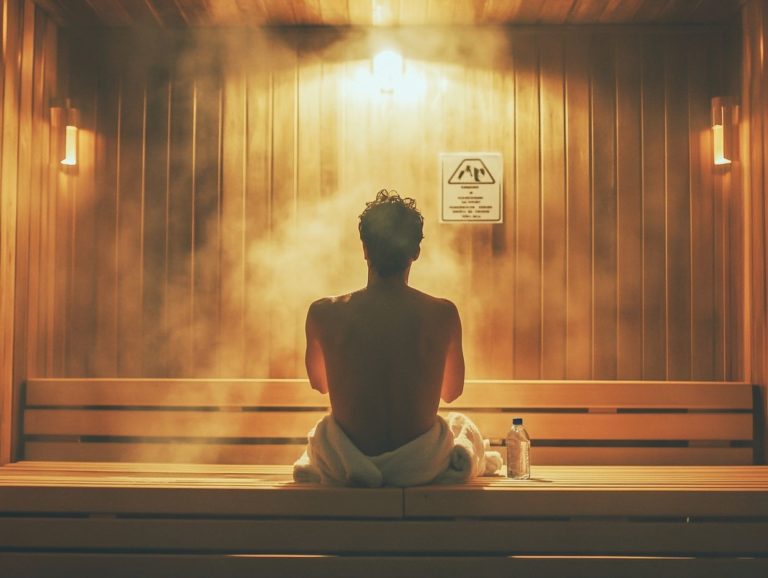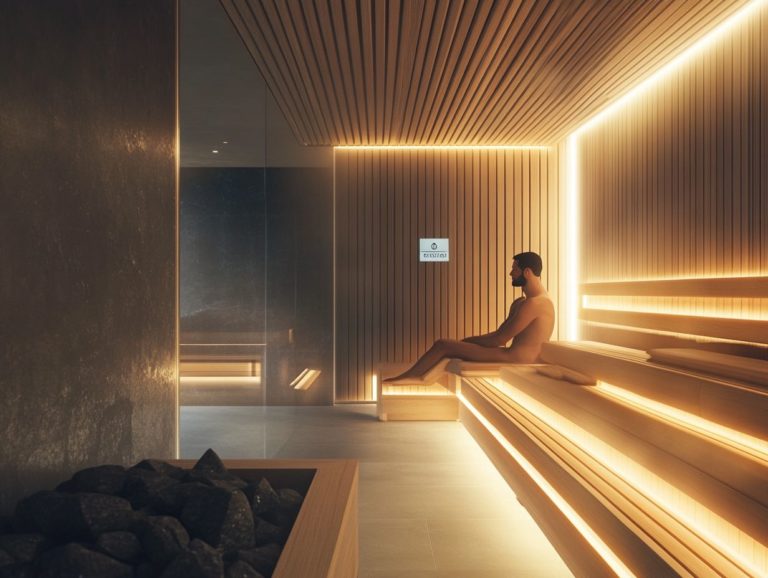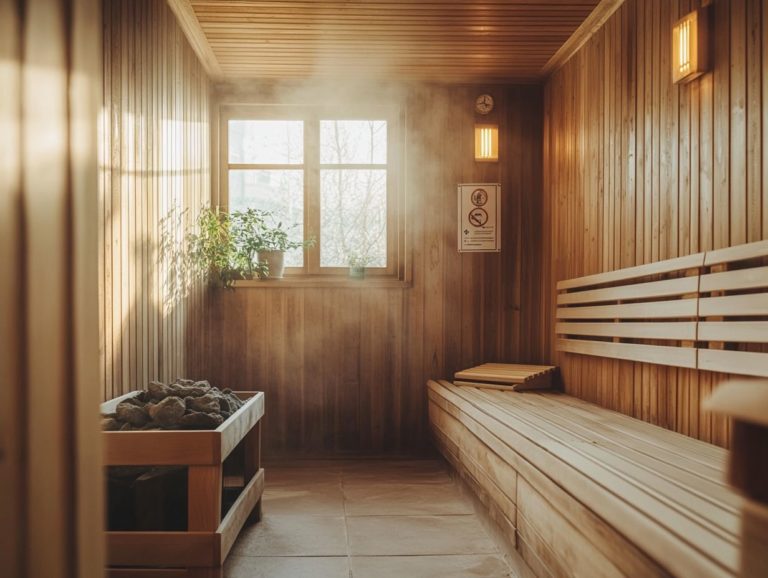Sauna Safety: The Importance of Collaboration
Saunas provide a luxurious escape from everyday life. Understanding safety is essential for a truly enjoyable experience.
This article explores sauna safety, highlights potential risks, and emphasizes why sauna owners, manufacturers, and users should work together. It lays out best practices for safe usage and maintenance, discusses industry regulations, and offers insights into creating a secure sauna environment at home.
By prioritizing sauna safety, you can boost your well-being and fully embrace this soothing tradition.
Contents
- Key Takeaways:
- Understanding Sauna Safety
- Potential Risks and Hazards
- Collaboration for Sauna Safety
- Best Practices for Sauna Safety
- Sauna Safety Regulations and Standards
- Ensuring Sauna Safety at Home
- Frequently Asked Questions
- What is the role of collaboration in ensuring sauna safety?
- Who should be involved in the collaboration process for sauna safety?
- How does collaboration help in identifying potential safety hazards in saunas?
- What are some preventive measures that can be implemented through collaboration?
- Why is it important for sauna owners and staff to collaborate with patrons on safety measures?
- How can collaboration aid in responding to emergencies in saunas?
Key Takeaways:

- Collaboration among sauna owners, manufacturers, and users is crucial for ensuring safety.
- Follow proper use and maintenance practices to minimize risks.
- Prioritize sauna safety at home with practical tips.
Understanding Sauna Safety
You must understand sauna safety to fully enjoy the incredible benefits, such as enhanced cardiovascular health and neuroprotection.
As saunas gain popularity worldwide, especially in California and Finland, it s important to emphasize safety measures that enhance your experience while reducing risks. This includes getting used to the heat gradually, recognizing key safety tips, and following user guidelines to create a secure environment for everyone, regardless of experience.
What is a Sauna?
A sauna is a compact retreat designed for dry and wet heat sessions. It’s perfect for relaxation and offers health benefits like cardiovascular improvement and detoxification. Originating from Finland, saunas come in various designs, from traditional wooden structures to sleek modern fiberglass steam rooms, catering to your preferences and health goals.
Historically, these heated havens have served as sanctuaries for physical rejuvenation and vibrant social hubs where communities connect. Different cultures interpret saunas uniquely; for example, the Japanese onsen highlights the therapeutic benefits of minerals, while the Russian banya is celebrated for its steam and invigorating use of birch branches.
No matter the style be it an infrared sauna that delivers targeted heat therapy or a classic steam room that enhances moisture the remarkable health advantages are undeniable. Regular sessions can lead to improved circulation, enhanced skin health, and significant stress reduction, making sauna experiences increasingly popular among health enthusiasts like you.
Potential Risks and Hazards
While saunas offer numerous health benefits, from detoxification to enhanced cardiovascular wellness, it’s crucial to be aware of the potential risks.
Recognizing hazards such as dehydration, overheating, and fainting is essential for fully enjoying the positive effects of your sauna sessions while minimizing unpleasant experiences.
By staying informed, you can maximize the benefits and ensure your time in the sauna is both enjoyable and safe.
Identifying Possible Dangers
Identifying potential dangers in sauna usage is essential for ensuring a safe and enjoyable experience, especially for newcomers. Common hazards like dehydration, heat exhaustion, and improper use of sauna equipment highlight the importance of being aware and prepared to mitigate these risks.
If you’re unfamiliar with the environment, you might not recognize your own limits, which can lead to prolonged exposure to high temperatures. It’s crucial to monitor your time inside and stay hydrated to avoid adverse effects.
Poor ventilation or malfunctioning heaters can increase the risk of overheating. As a new user, it s important to understand getting used to the heat gradually; gradually increasing your time in the sauna allows your body to adjust comfortably, minimizing heat-related illnesses and ensuring a beneficial experience.
Collaboration for Sauna Safety

Collaboration among sauna owners, manufacturers, and users is crucial for upholding safety standards in environments, from private homes in California to public spaces. By leveraging the expertise of stakeholders, including influential public figures like Garrett Wilkerson, the sauna community can create guidelines that enhance user safety and promote wellness.
This collective effort elevates safety measures and enriches the sauna experience for everyone.
Roles of Sauna Owners, Manufacturers, and Users
Sauna owners, manufacturers, and users all play vital roles in safeguarding health and safety. Each party can contribute to a community that prioritizes wellness while minimizing risks.
As a sauna owner, you are responsible for maintaining the facility. This includes ensuring adherence to health standards, inspecting equipment regularly, and keeping the space clean to prevent microbial growth.
Manufacturers must focus on delivering quality products. They should provide clear guidelines on use and installation and incorporate safety features into their designs.
As a user, it’s essential to educate yourself on sauna protocols, including appropriate duration and hydration practices. This knowledge helps you maximize benefits while keeping safety a priority.
By embracing these responsibilities together, you enhance your sauna experience and foster a culture that values health and safety.
Best Practices for Sauna Safety
Implementing best practices for sauna safety is essential for a positive experience and maximizing health benefits, such as neuroprotection, which helps protect your brain function, and enhanced mental well-being.
Familiarize yourself with proper guidelines on sauna use, maintenance, and safety tips. This knowledge helps you avoid risks and fully enjoy the therapeutic effects saunas offer.
Proper Use and Maintenance
Proper use and maintenance of saunas are critical for ensuring your safety and enhancing the overall wellness experience. Regular checks and adherence to user guidelines prevent malfunctions and allow you to reap health benefits.
To enjoy your sauna experience, prioritize cleanliness. Wipe down the benches regularly and ensure the heater functions optimally. Staying hydrated is crucial; drink plenty of water before and after each session since the warmth encourages sweating and can lead to dehydration.
Be mindful of the sauna temperature and session duration. Start with shorter visits at lower heat levels, gradually increasing the intensity as your body adjusts. Following these maintenance practices and safety tips enhances your sauna experience, providing relaxation, improved circulation, and relief from muscle tension.
Sauna Safety Regulations and Standards
Sauna safety regulations and standards are essential for enjoying the myriad health benefits of saunas while minimizing the risks of improper use. By adhering to industry guidelines, you enhance your safety and assist manufacturers in maintaining high-quality standards for their products.
This commitment to safety allows you to relax and enjoy the full rewards of your sauna experience with confidence.
Explore these guidelines now to transform your sauna experience!
Industry Guidelines and Requirements

Industry guidelines ensure safe sauna operation and maintenance. They help both manufacturers and users follow best practices.
By adhering to these safety standards, you can enjoy the therapeutic benefits of saunas while significantly reducing the risks of injury and health complications.
These guidelines cover essential aspects, including appropriate temperature limits, recommended session durations, and proper ventilation techniques. Following these standards minimizes the chances of dehydration and heat-related issues that can arise from improper maintenance.
Regulations require routine inspections and safety checks. This ensures that the equipment operates smoothly, preventing potential accidents. Such diligence cultivates a worry-free environment and elevates your overall experience by promoting relaxation and well-being.
Ultimately, embracing these practices safeguards everyone s health while enriching your sauna experience.
Ensuring Sauna Safety at Home
Ensuring sauna safety at home is paramount for maximizing health benefits. It minimizes risks tied to improper practices.
By implementing thoughtful safety measures and adhering to best practices, you can cultivate a secure and enjoyable sauna environment that enhances your overall well-being and promotes deep relaxation.
Tips for Safe Sauna Usage in Residential Settings
When considering safe sauna usage at home, it’s essential to adhere to safety rules, proper maintenance, and user guidelines. Following these recommendations creates an inviting environment that amplifies the health benefits associated with sauna use.
To maximize benefits while minimizing risks, ensure that your sauna is installed in a well-ventilated area. Maintain it at safe temperatures, typically ranging between 150 F to 195 F.
Regularly check electrical components and ensure all surfaces remain moisture-free to prevent hazards. Staying hydrated before and after sessions is crucial for enhancing detoxification and overall well-being.
Always consult with a healthcare provider, especially if you have pre-existing conditions. This step is crucial for understanding sauna safety and allows you to enjoy a soothing sauna experience with peace of mind.
Frequently Asked Questions
What is the role of collaboration in ensuring sauna safety?
Collaboration is essential for identifying potential safety hazards, implementing preventive measures, and responding to emergencies in a sauna setting.
Who should be involved in the collaboration process for sauna safety?

All individuals, including sauna owners, staff, and patrons, should actively participate in the collaboration process to ensure a safe and enjoyable sauna experience.
How does collaboration help in identifying potential safety hazards in saunas?
Through collaboration, individuals can share their knowledge and experiences for a comprehensive assessment of potential safety hazards in saunas.
What are some preventive measures that can be implemented through collaboration?
Collaboration helps in implementing measures like regular maintenance, proper ventilation, and clear safety guidelines to reduce the risk of accidents in saunas.
Why is it important for sauna owners and staff to collaborate with patrons on safety measures?
Including patrons allows for a better understanding of their needs and concerns, leading to a safer and more enjoyable sauna experience for all.
How can collaboration aid in responding to emergencies in saunas?
Collaboration enables individuals to develop protocols for emergencies, ensuring that everyone is trained and equipped to handle such situations effectively.





